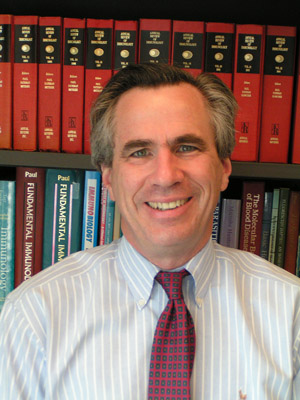 Dr. Robert SilicianoIn a realistic, if disheartening review in the April issue of the journal Trends in Microbiology, amfAR grantee Dr. Robert Siliciano of Johns Hopkins University, along with colleagues Katherine Bruner and Nina Hosmane, describe attempts at quantifying the reservoir of latently infected T cells in individuals with HIV. They conclude that “no available assay provides an accurate measurement of reservoir size.” This reality check is critical as the authors go on to emphasize that “underestimating the size of the latent reservoir may give the false impression that a patient is ‘cured’” when instead that individual may have a very small population of infected T cells, with virus waiting to emerge once antiretroviral therapy is withdrawn.
Dr. Robert SilicianoIn a realistic, if disheartening review in the April issue of the journal Trends in Microbiology, amfAR grantee Dr. Robert Siliciano of Johns Hopkins University, along with colleagues Katherine Bruner and Nina Hosmane, describe attempts at quantifying the reservoir of latently infected T cells in individuals with HIV. They conclude that “no available assay provides an accurate measurement of reservoir size.” This reality check is critical as the authors go on to emphasize that “underestimating the size of the latent reservoir may give the false impression that a patient is ‘cured’” when instead that individual may have a very small population of infected T cells, with virus waiting to emerge once antiretroviral therapy is withdrawn.
Siliciano and associates note that the present gold standard for reservoir measurement, the cumbersome viral outgrowth assay or VOA, has remained the standard since its description almost two decades ago. It is definitive in terms of providing a minimal estimate of the extent of latent infection. But the numbers derived by this method are some 300-fold lower than those obtained using DNA-based tests. The reason the latter cannot be considered a standard is that there is currently no reliable means to determine if HIV proviral DNA detected by these tests is clinically important. That is, is all of the HIV DNA counted capable of forming an infectious virus, or is most of it effete—the remnants of a mutated or otherwise compromised infection?
The lack of correlation between culture-based (VOA) and gene-based (DNA) reservoir assays, a flaw found in the eight different methods analyzed in Siliciano’s paper, is a major impediment to evaluating clinical trials aimed at curing HIV. But it is also a major focus of the research to be funded by amfAR’s Countdown to a Cure for AIDS, an ambitious $100 million research initiative to find the scientific basis for a cure by 2020.
Dr. Laurence is amfAR’s senior scientific consultant.